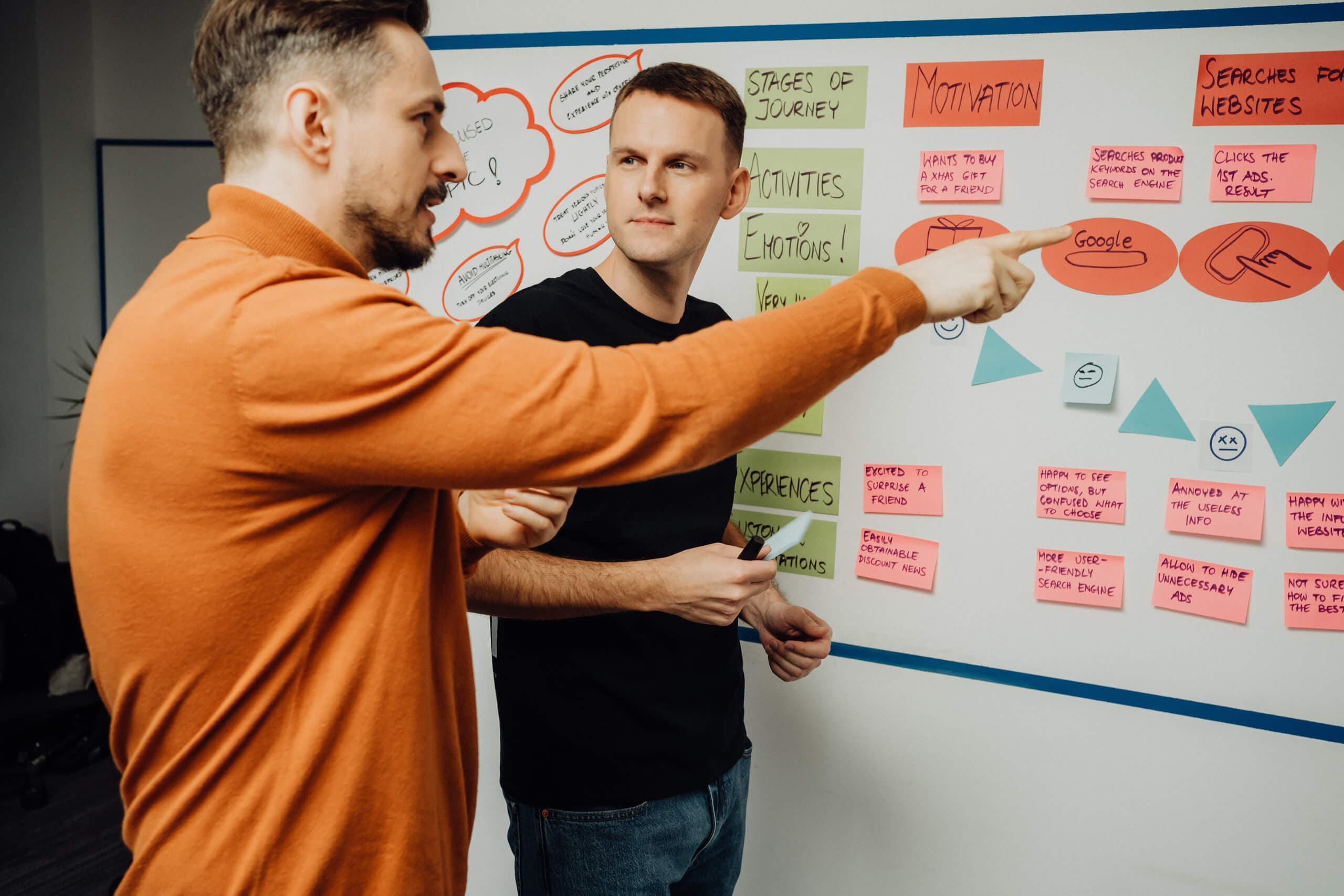What's the Difference Between Agile and Waterfall Methodologies?
David Adamick
May 05, 2023・7 min read
Table of Content
What is Agile methodology?
The Foundations of Agile:
Types of Agile
What is Waterfall methodology?
The 5 phases of the Waterfall model
Pros of Agile project management
Cons of Agile project management
Pros of Waterfall project management
Cons of Waterfall project management
Agile and Waterfall Methodologies - A Recap of Elements
Timeline
Flexibility
Stakeholder involvement
Budget
Agile vs. Waterfall - which is best for your project?
Moving from Waterfall to Agile methodologies
Agile project management at Startup House
Product Roadmaps
Requirements
Backlog
Agile metrics
Conclusion
Still undecided on whether you adopt an Agile or Waterfall approach to your software development project? As experienced developers, we know the feeling well, and understand even better when an entrepreneur asks: 'Which project management methodology is best for my software development processes?'
To find out, it's best we begin simply with 'What's the difference between Agile and Waterfall methodologies?' Lots, as it turns out.
So, let's revisit and refresh these Agile and Waterfall methods to help you maximize your resources and ensure your projects are run as smoothly and successfully as possible.

What is Agile methodology?
Agile is based on the Scrum framework and is an iterative, adaptive, wholly flexible approach to project management. It was developed to more effectively address the change in the technological landscape that is constant in the software development process.
As this process can sometimes take years, Agile's more fluid nature makes it more accommodating of directional changes a project may need to take, be they at an early or later stage.
Agile achieves this by dividing a project up into smaller project units commonly referred to as sprints. Following each sprint, Agile teams and stakeholders review the work done, generate feedback, then make the appropriate adjustments for the next set of iterations. This is repeated until project completion.
The ultimate purpose of Agile project management is the early and continuous delivery of value throughout the duration of the project, rather than concluding the project with a finalized product.
The Agile methodology was formalized in 2001 in what is now known as the Agile Manifesto, which comprises four core values and 12 principles. These values and principles oblige among other things intensive inter-team collaboration, extensive stakeholder interaction, full flexibility, and openness to change to facilitate continual software development.
The Foundations of Agile:
- Product Backlog: A prioritized list of features, user stories, and other requirements that are necessary for development team to focus on and deliver.
- Sprint Planning: The team conducts sprint planning at the beginning of each sprint to define the scope of work and list of tasks to be accomplished during the sprint.
- Daily Meeting: The team meets daily for a short meeting to discuss progress, identify obstacles, and adjust plans accordingly.
- Sprint Review: At the end of each sprint, the team conducts a sprint review meeting to demonstrate the working software they have delivered and gather feedback from stakeholders.
- Sprint Retrospective: The team holds a retrospective meeting after the sprint review to reflect on their process, identify areas for improvement, and adjust their practices accordingly.
- Increment: The team delivers working software at the end of each sprint, which allows for continuous feedback and ensures that the product is always in a releasable state.
(For more specifics on Agile, check out one of our earlier blogs here.)
Types of Agile
There are many ways to and of Agile methodology, ones where all adherents uphold its principles differently. The two most popular by far are Scrum and Kanban.
Scrum
This is a project management framework typically employed by software development teams to structure and manage their work, and do so using a set of values, principles, and practices. Scrum is about learning from experience, self-organization/reflection, and observing the perpetual objective of self-improvement.
Kanban
A framework for implementing agile and DevOps software development. With Kanban, team members can see at any given time all project aspects and phases visually represented on a Kanban board. As such, Kanban projects offer full transparency of work.
What is Waterfall methodology?
By contrast, the Waterfall methodology is a more traditional project management approach, geared as it is toward achieving end results that are pre-defined. This is to say, these objective-fulfilling results are clearly established before a project is begun.
Such a linear approach to project management is better suited for certain software development programs such as those of government institutions that have clear objectives already in mind.

The 5 phases of the Waterfall model
Since the traditional Waterfall model is a sequential design process, it is therefore about project direction. To ensure this direction is clear, it imposes five clearly defined development phases:
Requirements
Here's where project development defines the big picture of what your project will entail and what its overall requirements will be. This could be, for example, that a piece of software achieves a certain number of transactions per day.
Design
Here is where ways of designing solutions to meet these requirements are developed. In the example above, this could mean considering all the possibilities for supporting a given (usually large) number of transactions per day.
Implementation
When a candidate design is selected then implemented with the relevant technology.
Verification
Once implemented, a development team will test whether it validates the requirements as defined in phase one. Again, in the example of accommodating a certain number of daily transactions, here's where the capacity to do so would be verified.
Maintenance
But it doesn't just end with product verification. All systems require maintenance, which means establishing strategies for the ongoing implementation of updates and upgrades. Development teams must anticipate and test for errors and ensure they can fix them if and when they occur.
Pros of Agile project management
- Higher business value – a more intense focus on customer needs and solutions to those needs.
- Better flexibility/market adaptability – Agile allows for easier, more immediate pivoting in response to shifting market requirements.
- Minimized risk – the risks of having a minimal market-fit can be more readily addressed by the immediate collection of user feedback.
- Short-term deadlines – more easily managed; promotes greater efficiency and productivity.
- Costly product flaws/errors/problems are more easily pre-empted and avoided.
- Client-facing - more direct stakeholder input; a greater degree of collaboration, faster feedback cycles, and project progress reporting.
- Product-to-market process drastically improved.
Cons of Agile project management
- Given the susceptibility to change, Agile project timelines are difficult to project from the outset.
- Potential overlap of team efforts owing to the multiple-phasing structure of Agile development.
- Project interdependencies may not be clearly defined.
- Technical learning curves are inherent and can affect costs.
Pros of Waterfall project management
- Project structure and product vision are more concretely defined from the outset - this means that far less team coordination is required throughout the software development process. It also means the dependencies of work are more clearly defined.
- Project requirements are determined at a much earlier stage in Waterfall, saving time for project management, and allowing for more accurate project cost estimations.
- The obligation of deliverables before moving to the next project phase ensures a more structured workflow.
- This facilitates a more methodical, structured, and better-documented product design phase.
Cons of Waterfall project management
- The obligation to complete each phase in the development process can lead to a more time-consuming process.
- Because product issues, flaws, and/or errors can be missed at earlier development phases, they will often require costly backtracking processes to identify and rectify these problems.
- With waterfall methodology, its pre-defined objectives and structure leave little or no room for flexibility, should requirements change at any point during project development.
Agile and Waterfall Methodologies - A Recap of Elements
Timeline
Agile's timeline is wholly flexible whereas Waterfall's is fixed. The Agile approach encourages experimentation and adapts its timeline accordingly; Waterfall envisages a predetermined shape to its completion schedule.
Flexibility
Because all phases in Waterfall project management must be completed before any further progress can be made, the Waterfall model may be seen as inflexible relative to Agile.
By contrast, flexibility is the essence of Agile methodology: as it iterates its workflow into sprints, the Agile model ensures easier adaptation to different directions and a capacity to absorb and utilize new information even in the later stages of a given project.
Stakeholder involvement
With the exception of specific deliverables, the Waterfall model pre-establishes set goals prior to beginning any work and therefore involves very little input from stakeholders – if any at all. Such a pre-defined project outline precludes any necessity for client feedback.
Agile projects, on the other hand, encourage client interaction at every project stage. It is the "early and continuous delivery of valuable software" (Agile Manifesto) that necessitates a stakeholder's close involvement so that Agile teams may gain continuous feedback for guiding the product development process to its completion.
Budget
Agile project budgets naturally reflect the flexible nature of the Agile framework itself: given its iterative, adaptive, and creative approach, Agile project budgeting will be set accordingly.
Just as naturally, the Waterfall model fixes a budget from the outset. Owing to its pre-determining approach, software projects using the Waterfall methodology are granted very little margin for budget readjustments mid-project.

Agile vs. Waterfall - which is best for your project?
We've refreshed the key elements of Agile and Waterfall; now you need to address the nature of your project. Are your objectives for it already concrete; do you already envisage its clear outcome? And therefore for meeting these objectives, does your project require a more strictly structured project management framework? Then Waterfall.
Or do you prefer to integrate your stakeholders into every phase of your project development? Is your process more about trial & error, evolution, and pivoting according to changing user requirements?
If it's the latter, then Agile is the clear option.
Moving from Waterfall to Agile methodologies
At Startup House, we champion Agile project development. We prefer a methodology that is fully flexible and oriented around our customers more intimately. The more client-facing it is, the better we like it. This is why we routinely encourage our partners to adopt the Agile method.
Agile project management at Startup House
Here’s how we harness Agile’s full potential to provide full benefits to our stakeholders and project managers:
- Higher business value – With Agile, we focus on customer needs first. From the early stages, we deliver features that solve real life problems, and so we generate business value for all. By focusing on Business Value, each iteration achieves the results that are most essential from the End User's perspective.
- Inspect and adapt – We validate software products and hone their essential features through our continuous work in the market and with end users. This empirical approach of inspection and adaptation lets us reflect on how we can become ever more effective in the development process.
- Customer-centric – By centering on true End User problems, we ensure they are solved first. This increases the software product's value according to market needs.
- Collaboration – Partnership with a cross-functional team of specialists brings a multi-perspective approach to product development and its inevitable challenges. This way, better solutions are created and risks more effectively mitigated.
- Incremental delivery – Each iteration brings greater refinement, comprehension and maturity to a software product, and thus a more direct reach toward the right solution-market fit.
- Low risk – Agile enables us to continually deliver valuable product sections and collect user feedback immediately. We can quickly address the risks of having a minimal market-fit.
- Higher market adaptability – Markets are dynamic and user needs are always evolving. With Agile, we're ready to pivot at any cycle of work, to meet new criteria.
For teams well versed in the Waterfall method, switching to Agile can at first be challenging since it requires some changes in tack. That is to say, changes in certain processes whilst grasping two important policies:
- That a project manager or product owner optimizes agile team members' output value by prioritizing only the work that is most important.
- That a team only takes on work it has the capacity for, and that the project manager does not force it beyond this capacity nor impose random deadlines.
All this will mean incorporating the following core elements of the Agile model:
Product Roadmaps
Your action plan. The blueprint for how your product or solution will evolve over time. Here you outline future product functionalities and features, and when you aspire to release them.
Requirements
Each milestone along the road(map) will oblige a brief list of necessary functionalities for achieving this milestone.
Backlog
Your roadmap incarnate. Find the priorities for your agile program here. Bugs, enhancements, technical jobs, architectural tasks -- you name it. Plan your iterations here, also. Your backlog is how your team knows what it'll be up to.
Agile metrics
Gage your productivity throughout the varying stages of your project development. Assess product quality and track your team's performance. Here, the use of burndown charts and control charts is de rigueur.
 Conclusion
Conclusion
Ultimately, your decision on whether to opt for Agile or Waterfall depends on the dynamics of your project. In our experience, these dynamics have mostly been collaborative and kinetic. This has often meant rapidly paced software development projects that are responsive and experimental. Where founder/dev team interaction is a near-daily routine.
However, for your current project, you may already foresee the outcomes you strive for. Yours may require concrete deliverables before moving to its next phase of development. Perhaps ongoing stakeholder/owner involvement would a hindrance. Perhaps you need your dev team to 'just get on with it.
The project management framework you choose can have a massive impact on how your development process fares in the long run. Indeed, such frameworks can make or break products.
Here, Startup House can help you consider and decide upon either approach. Although resolute champions of and specialists in Agile, we have the full capacity to implement Waterfall for your project, should this be more appropriate. Ultimately, we will prioritize whichever project management framework maximizes your idea's potential most efficiently and gives your product its best chance of success.
Need some more detailed guidance? It's at Startup House – contact us today.
Digital Transformation Strategy for Siemens Finance
Cloud-based platform for Siemens Financial Services in Poland


You may also like...

Understanding T&M Contract Management in Agile Projects: A Practical Guide
Time and Materials (T&M) contracts align seamlessly with Agile methodologies by providing flexibility and adaptability in evolving project scopes. This guide explores how to manage T&M contracts effectively, covering key elements, risks, and best practices to ensure success in Agile projects.
Alexander Stasiak
Dec 09, 2024・13 min read

How Wireframes Enhance Agile Development: A Simple Guide
Wireframes play a critical role in agile development by visualizing structure, streamlining communication, and enabling rapid feedback. They help teams align on goals, iterate quickly, and create user-centered products efficiently.
Alexander Stasiak
Nov 28, 2024・9 min read

Agile travel software development
Agile travel software development offers a dynamic approach to creating travel applications. By emphasizing collaboration and responsiveness, Agile ensures travel software is functional and aligned with market trends. Explore how Agile methodologies benefit the travel industry with continuous improvement and rapid innovation.
Marek Majdak
Jan 17, 2024・8 min read
Let’s build your next digital product — faster, safer, smarter.
Book a free consultationWork with a team trusted by top-tier companies.








